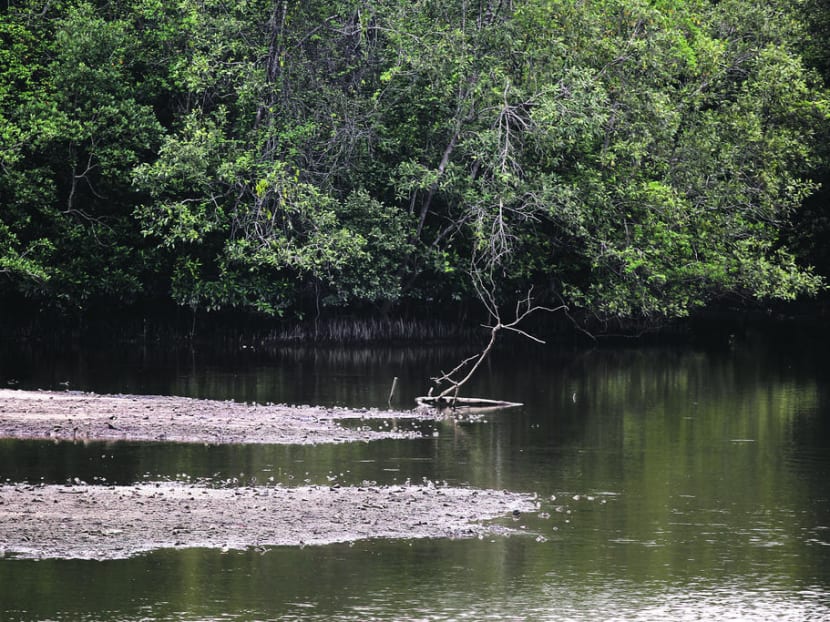Explainer: Why we need to use nature in the fight against climate change
SINGAPORE — In the fight against climate change, solutions found in nature will be part of the Republic's first line of defence.

Mangroves at Sungei Buloh Wetland Reserve. Singapore is not alone in fighting climate change, nor the only country that is using nature-based solutions.
SINGAPORE — In the fight against climate change, solutions found in nature will be part of the Republic's first line of defence.
While Singapore has big plans to invest in hard infrastructure to deal with the effects of rising sea levels, it also plans to employ “nature-based solutions”, Environment and Water Resources Minister Masagos Zulkifli said on Monday (Oct 21).
Speaking at the Intergovernmental Panel on Climate Change (IPCC) meeting, Mr Masagos noted that over 2 million trees, more than 350 parks and four nature reserves have been planted and built across Singapore.
On top of that, an additional 250,000 native trees and shrubs will be planted as part of the Forest Restoration Action Plan.
“To boost our natural defences such as mangroves, we take both hard and soft engineering approaches to mitigate coastal erosion and actively restore our mangrove areas,” he added.
These nature-based solutions come on top of hard infrastructure projects that Singapore is studying. Prime Minister Lee Hsien Loong said earlier this year that the Republic is looking into mitigating the rise of sea levels by building polders and dykes and reclaiming offshore islands.
Singapore is not alone in fighting climate change, nor the only country that is using nature-based solutions. TODAY takes a look at what other nations are doing on this front, and why such solutions are necessary.
WHAT DO NATURE-BASED SOLUTIONS LOOK LIKE?
Experts TODAY spoke to said that in Singapore, there are many nature-based solutions that can be implemented, including restoring mangroves, marshes, oyster beds, corals and coastal dunes.
The vice president of non-profit organisation Earth Society Loh Chip Khoon believes that such nature-based solutions are the best way to fight climate change, because they contribute to the biodiversity and make cities greener.
However, he noted that these ecosystems are highly threatened by human activities such as deforestation and land reclamation, and so any attempts to restore them might have limited impact.
“Restoring mangroves and planting more trees in Singapore will be sustainable only if the rate of deforestation drops,” he said, adding that the two activities might cancel each other out if done concurrently.
“These nature-based solutions are important to fight climate change, but at the same time, we must preserve the biodiversity that we already have,” said Mr Loh.
HOW DO THESE SOLUTIONS WORK?
“Natural infrastructure” such as mangroves and dunes help to provide shoreline protection by buffering the island from storms and flooding, decreasing the impact of wave energy and run-up to shore, slowing water movement and increasing water infiltration, said Professor Benjamin Horton of Nanyang Technological University’s (NTU) Asian School of the Environment.
All these will help to mitigate the effects of rising sea levels and decrease the chances of flooding in the event of extreme weather.
Prof Horton pointed out that when the Boxing Day tsunami of 2004 hit certain parts of South-east Asia, the damage done to villages located near mangroves was minimised and the death tolls were lower.
“Coastal ecosystems protect people, infrastructure and economic activities from flooding, erosion and sea-level rise. Increasingly, people are looking to prioritising nature as the first line of defence for coastal protection, as well as an engine of economic growth,” he said.
NTU associate professor Adam Switzer, who specialises in geographical changes around coastal areas, gave the example of how the coastal dunes around New Jersey softened the blow when Hurricane Sandy hit the city seven years ago.
He explained that the dunes acted as a barrier to surging waves and tides, blunting the effect on the coasts of neighbouring beaches.
“Nature-based solutions can be very effective and very positive for communities,” he said.
WHY DO CLIMATE EXPERTS PREFER NATURE-BASED SOLUTIONS?
Aside from being an effective measure against climate change, experts said that nature-based solutions also do less damage to the environment than hard infrastructure.
Dykes, polders and sea walls, which can help mitigate against rising sea levels, can also have a negative impact on coastal ecosystems and biodiversity, they noted.
They could even cause unintended consequences, such as creating erosion elsewhere along the coast that they were built to protect.
Nature-based solutions are not only cheaper than hard infrastructure, they also help improve the health of other ecosystems, said the deputy leader of the World Wildlife Fund’s global climate and energy practice, Ms Vanessa Perez-Cirera.
“As we make choices about how to adapt food, water, infrastructure and cities to the changing climate, it is imperative that we avoid further degrading the natural environment,” she said.
“If we rely on nature to provide adaptation and mitigation benefits for people, it is critical that we help nature itself adapt to the changing climate.”








